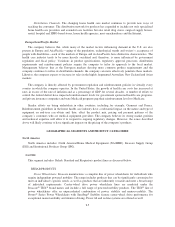Invacare 2009 Annual Report Download - page 20
Download and view the complete annual report
Please find page 20 of the 2009 Invacare annual report below. You can navigate through the pages in the report by either clicking on the pages listed below, or by using the keyword search tool below to find specific information within the annual report.North America
The company has focused its factories in North America on the production of powered mobility and custom
manual wheelchairs and seating products, the fully integrated manufacture of homecare and institutional care
beds, the final assembly of respiratory products and the integrated component fabrication, painting and final
assembly of a variety of standard manual wheelchairs and personal care products. The company operates four
major factories located in Elyria, Ohio; Sanford, Florida; London, Ontario and Reynosa, Mexico.
Asia/Pacific
The company has as it key strategic imperatives to improve its customer delivery effectiveness, to expand
its reach into all customer channels in all major metropolitan centers and to integrate its distribution operations
across the country.
Europe
The company has nine manufacturing/assembly facilities spread throughout Europe with the capability to
manufacture patient aid, wheelchair, powered mobility, bath safety, beds and patient transport products. The
European manufacturing and logistics facilities are focused on accelerating opportunities for streamlining to gain
productivity improvements in cost and quality over the next few years.
GOVERNMENT REGULATION
The company is directly affected by government regulation and reimbursement policies in virtually every
country in which it operates. Government regulations and health care policy differ from country to country, and
within some countries (most notably the U.S., European Union, Australia and Canada), from state to state or
province to province. Changes in regulations and health care policy take place frequently and can impact the size,
growth potential and profitability of products sold in each market.
In the U.S., the growth of health care costs has increased at rates in excess of the rate of inflation and as a
percentage of GDP for several decades. A number of efforts to control the federal deficit have impacted
reimbursement levels for government sponsored health care programs and private insurance companies often
imitate changes made in federal programs. Reimbursement guidelines in the home health care industry have a
substantial impact on the nature and type of equipment an end user can obtain and thus, affect the product mix,
pricing and payment patterns of the company’s customers who are the HME providers.
The company continues its pro-active efforts to shape public policy that impacts home and community-
based, non-acute health care. The company is currently very active with federal legislation and regulatory policy
makers. Invacare believes that these efforts give the company a competitive advantage in two ways. First,
customers frequently express appreciation for the company’s efforts on behalf of the entire industry. Second,
sometimes the company has the ability to anticipate and plan for changes in public policy, unlike most other
HME manufacturers who must react to change after it occurs.
The United States Food and Drug Administration (the “FDA”) regulates the manufacture and sale of
medical devices. Under such regulation, medical devices are classified as Class I, Class II or Class III devices.
The company’s principal products are designated as Class I or Class II devices. In general, Class I devices must
comply with labeling and record keeping requirements and are subject to other general controls. In addition to
general controls, certain Class II devices must comply with product design and manufacturing controls
established by the FDA. Domestic and foreign manufacturers of medical devices distributed commercially in the
U.S. are subject to periodic inspections by the FDA. Furthermore, state, local and foreign governments have
adopted regulations relating to the design, manufacture and marketing of health care products. During 2008 and
2009, the FDA inspected the Taylor Street manufacturing facility in Elyria, Ohio and Invacare’s manufacturing
facility in Sanford, Florida. At the conclusion of each inspection the FDA issued its inspectional observations on
I-14
























